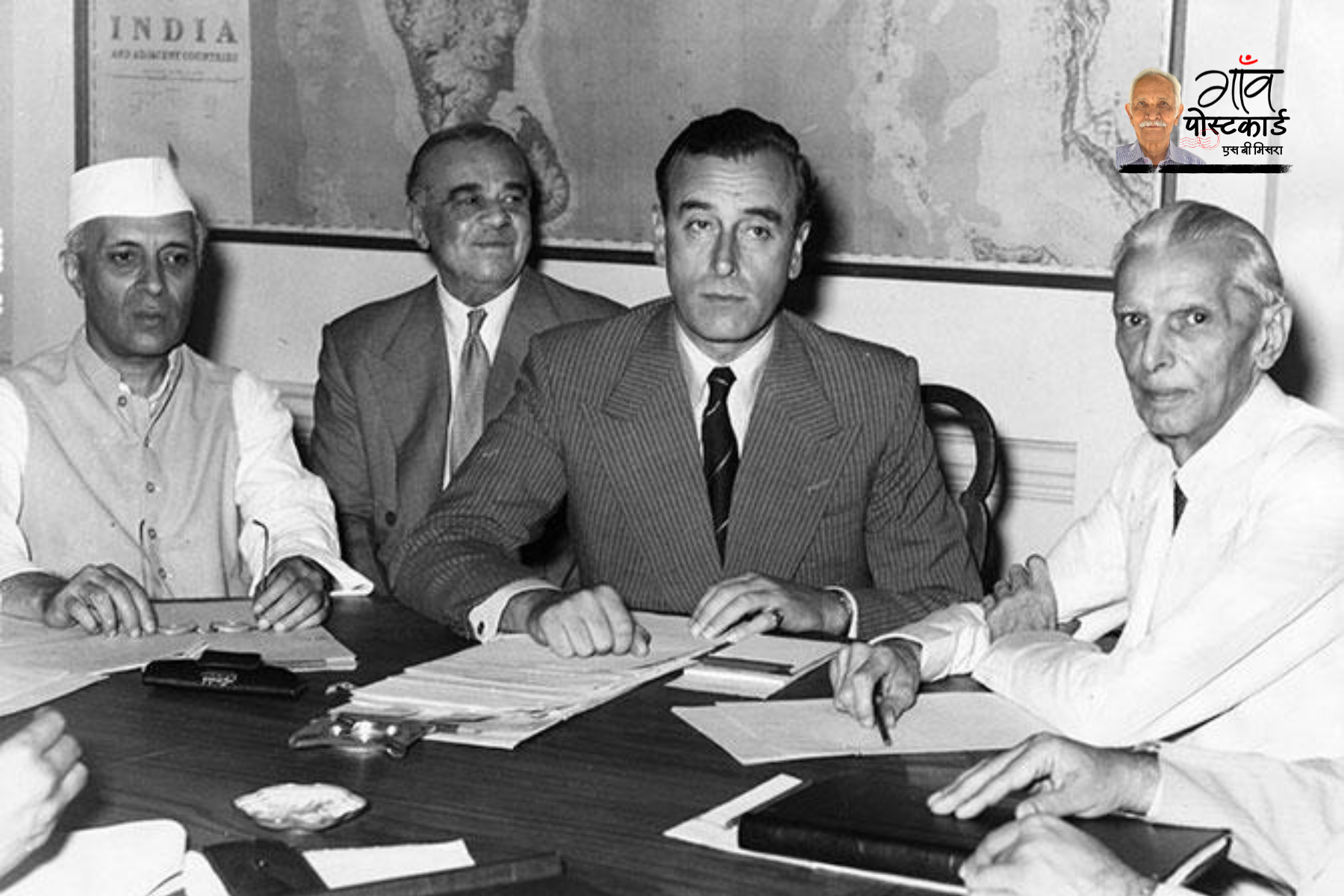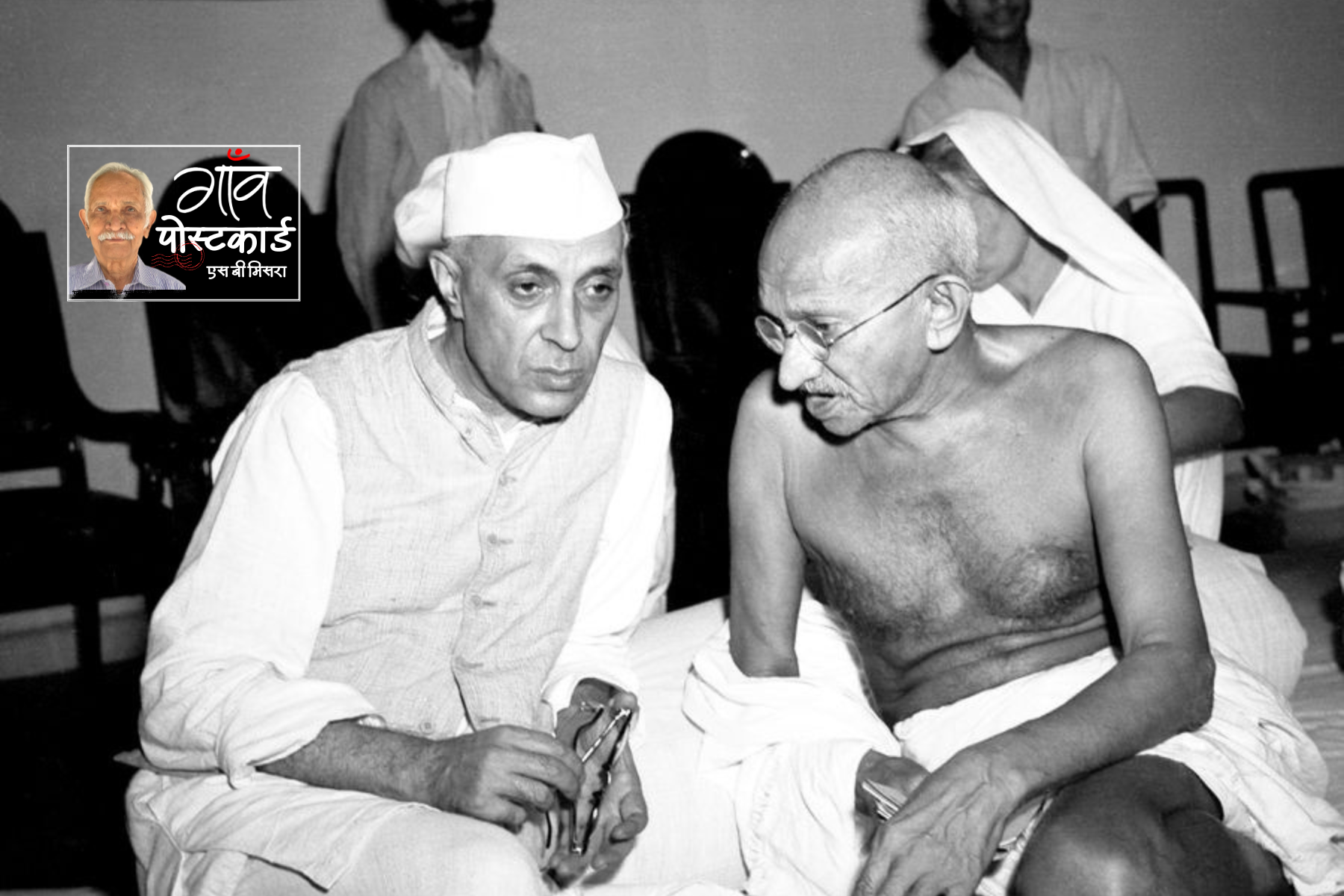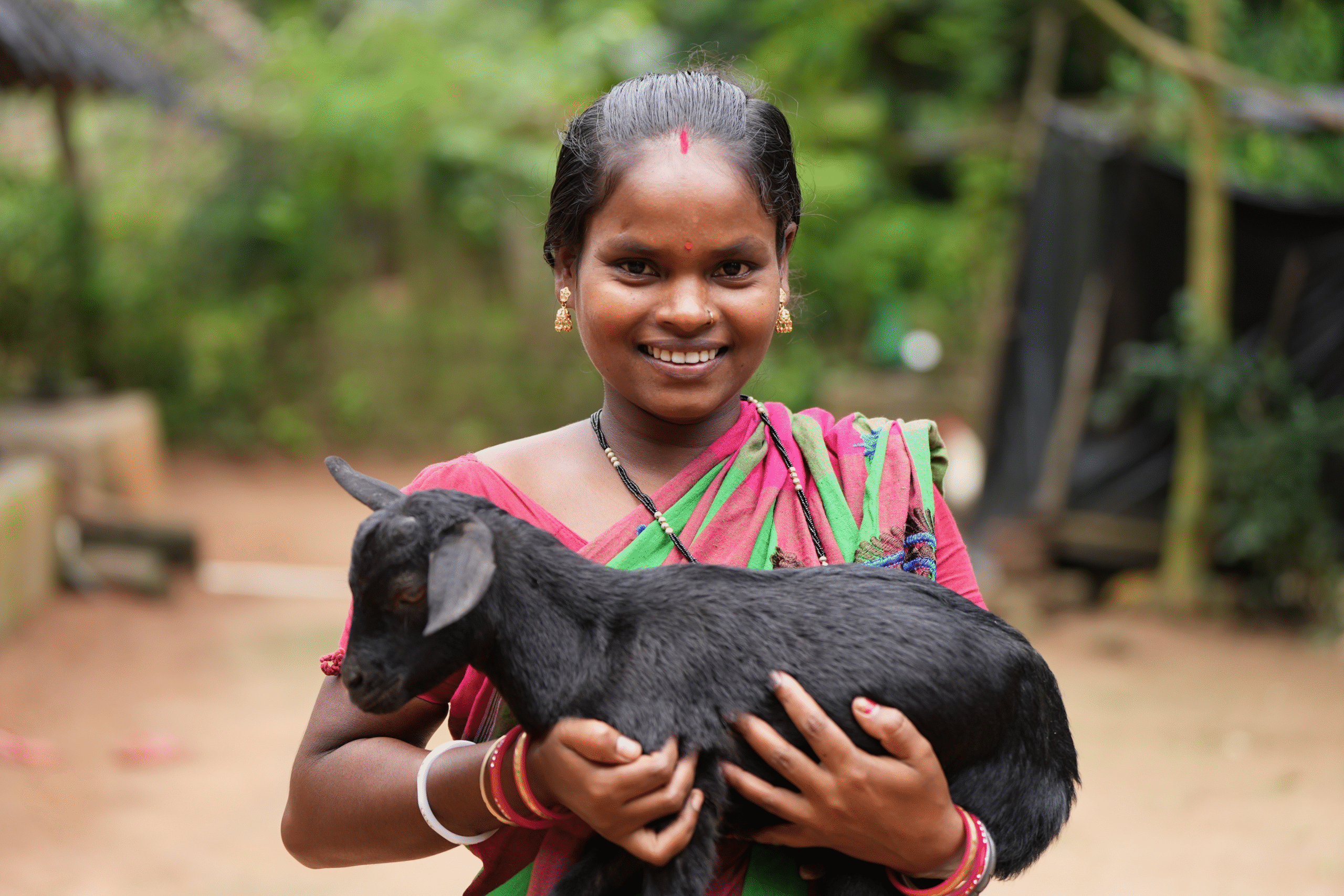Jaisalmer, Rajasthan
Dressed in a white pajama and kurta along with a red headgear, Sumer Singh Bhaati, a 38-year-old resident of Sanwta Raasla village in Rajasthan’s Jaisalmer district is raising funds to erect a memorial in the memory of a bird which died in 2020.
The bird wasn’t his pet, nor was he emotionally attached to that particular bird. Nevertheless, he wants to dedicate a memorial to it.
“I am not very educated. I don’t claim to know what’s important or what’s not but I just cannot remain a mute spectator to the deaths of godawan pakshi (Great Indian Bustard) which is slowly fading away into oblivion. Even a single death makes me anxious and I believe that this memorial will help raise awareness amongst the villagers about the need to conserve these birds,” Bhaati told Gaon Connection.
The godawan pakshi Bhaati talked about is the Great Indian bustard which is a large indigenous bird native to the Thar desert of Rajasthan and is critically endangered. Its population is estimated to have been reduced to 125 in the country.
A cattle rearer by occupation, Bhaati plays a vital role in the conservation of the critically endangered bird species. “Whenever I get to know about an unfortunate accident, I immediately inform the forest officials about it. The officials send a rescue team which provides medical aid to the injured bird. This helps in timely action which is vital or saving the lives of the birds,” he told Gaon Connection.
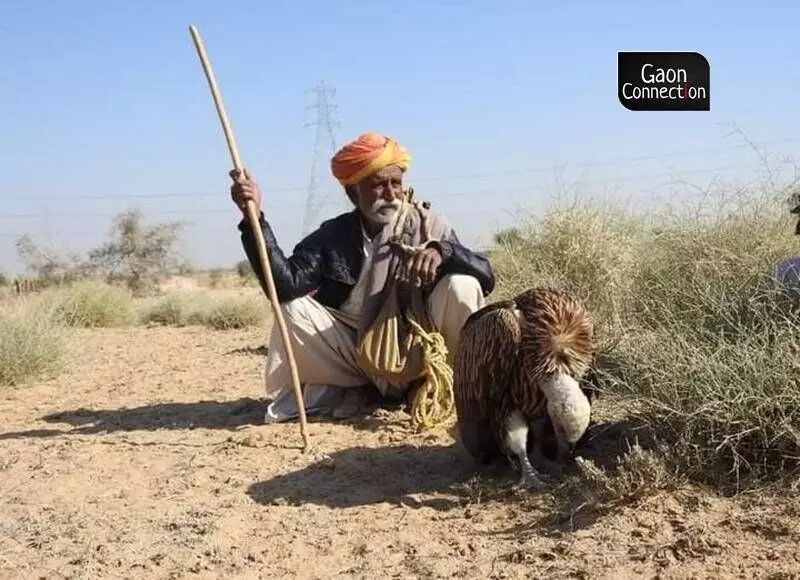
Bhaati is not the only cattle rearer who doubles up as a wildlife conservator. There are a total of 150 such villagers who have been trained by a Delhi-based wildlife expert named Sumit Dookia to contribute efforts towards the conservation of the Great Indian bustard.
Urs Khan is another such cattle rearer from Sam village which is situated at a distance of 90 kilometres from Bhaati’s village.
“After being trained by Sumit sir, I am fascinated by how important these godawan pakshi are for our paryavaran (environment). I try my best to be able to save a bird’s life but I’ll be glad if we are provided some financial aid by the government for keeping a vigil in the scorching desert. I walk up to forty kilometres in a single day,” Khan told Gaon Connection.
Dookia has been training these cattle rearers for the last seven years.
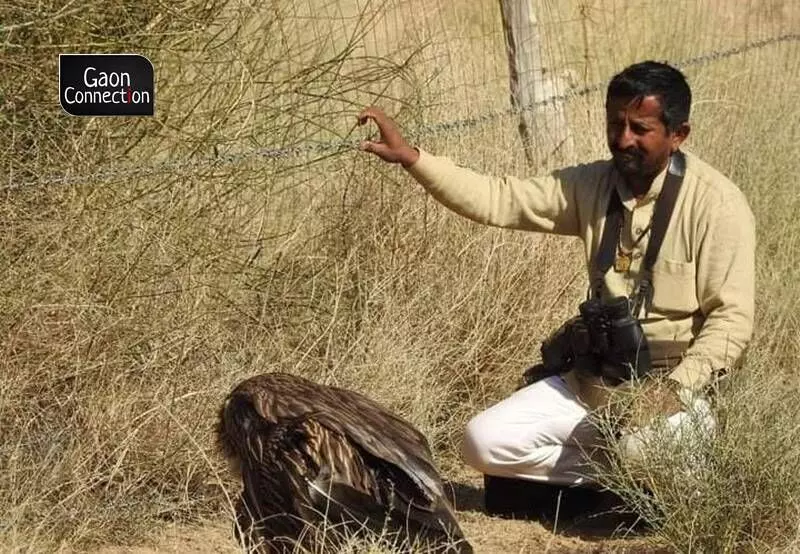
According to the Britannica website, the largest concentration of great Indian bustards, perhaps 120 birds, occurs in the state of Rajasthan. Photo by arrangement
“The results are really encouraging. We have been successful in raising awareness of the local villagers about the imminent need to conserve the Great Indian bustard. The cattle rearers are now substantially adept in identifying issues detrimental to these birds and they serve as a vital ground support unit,” Dookia told Gaon Connection.
Threat of extinction looms large
The population of the Great Indian bustard has been on a fast decline for decades. According to the official data provided by Rajasthan’s Forest Department, the bustard population was 1,960 in 1969, 745 in 1978, 600 in 2001, 300 in 2006, and 150 in 2018. There hasn’t been an official counting of the critically endangered bird since 2018.
When Gaon Connection contacted the district forest officer of Jaisalmer’s Desert National Park about the gap in counting for three years, Kapil Chandrawal informed that inadvertent situation arising out of the COVID-19 pandemic had suspended the counting exercise.
“We will conduct the counting exercise soon as the COVID-19 is now receding,” he said.
In 1994, these birds were listed as an endangered species on the International Union for Conservation of Nature’s (IUCN) Red List of Threatened Species but by 2011, the population decline was so steep that the IUCN reclassified the species as ‘critically endangered’.
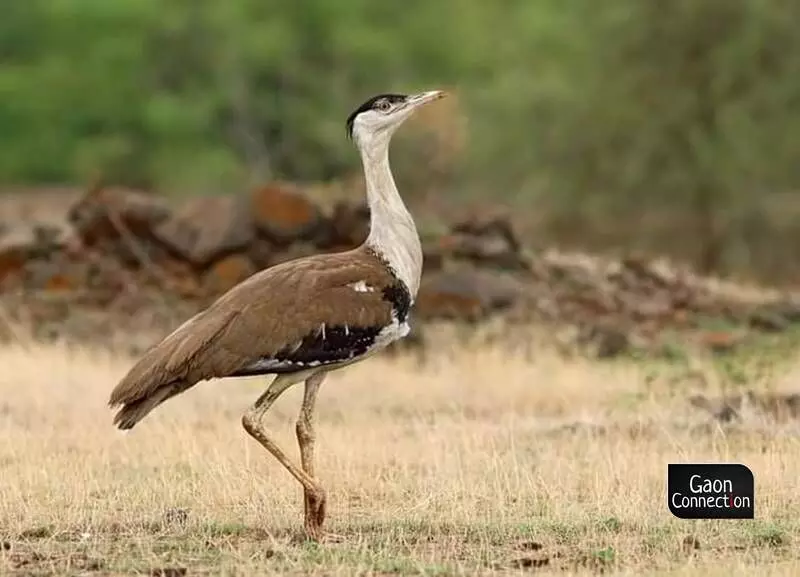
The Wildlife Institute of India (WII) estimates that 18 of these birds die each year due to collision with power lines, making power lines the most significant threat to these last remaining Great Indian bustards. Photo by arrangement
According to the Britannica website, the largest concentration of great Indian bustards, perhaps 120 birds, occurs in the state of Rajasthan.
“Most females lay a single egg, but clutches of two eggs are not unknown. She incubates the egg for approximately one month before it hatches. Hatchlings are capable of feeding on their own after one week, and they become fully fledged when they are 30–35 days old,” the profile of the bird on Britannica website mentioned.
Declared as the state bird of Rajasthan, the Great Indian bustard are tall birds with long legs and a long neck and the tallest individuals may stand up to 1.2 metres (4 feet) tall. The male and female sexes are roughly the same size, with the largest individuals weighing upto 15 kilogrammes (33 pounds).
In 1960, noted bird conservator Salim Ali recommended that it should be declared as the national bird of India.
Also, in 2013, the Rajasthan government launched the Project Great Indian bustard to conserve the endangered species.
“Being custodian of more than 50 percent population of bustard across the world, the desert state of Rajasthan does not want to be a mere spectator of the total extermination of the species across the globe, took up the responsibility for the conservation of this species and its habitat for our future generations by becoming a first state in launching the Project Bustard, initially in the DNP Sanctuary, located in Jaisalmer district of Rajasthan,” the Forest Department mentions on its website.
Wildlife enthusiast and a resident of the Dholiya village in Jaisalmer’s Pokhran, Radheshyam Pemani was part of the project in which official counting of the Great Indian bustard was conducted in Rajasthan in 2018.
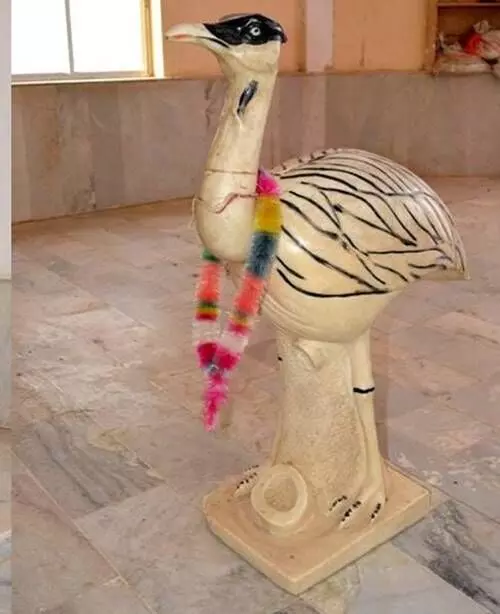
“The stray dogs and high tension electricity wires are two of the biggest threats to these birds. This year alone, a total of six birds have died by coming in contact with these wires,” Pemani told Gaon Connection.
Breeding centre helps in increasing population
In a bid to increase the dwindling number of the Great Indian bustard, breeding centres have been set up by the state government and in 2019, eight chickens were born out of these centres.
But the rate of reproduction of these critically endangered birds are too low to compensate for the losses. A single adult female bustard lays one egg per year and the chances of a hatchling surviving to adulthood are ridden with uncertainties.
Officials told Gaon Connection on the condition of anonymity that several of these breeding centres are housed by a single female bird which keeps the breeding rate abysmally low.
In these centres, a total of eight eggs had hatched in 2019, five in 2020, and three in 2021.
High tension wires biggest impediment
In order to prevent these birds from coming in contact with the high-tension electricity wires, Wildlife Conservation Society, a New York-based non-governmental organisation has installed a total of 1,842 bird diverters in the region.
These bird diverters are bright-coloured hangings installed on the wires to help the bustards in flying away from the electricity wires.
The Wildlife Institute of India (WII) estimates that 18 of these birds die each year due to collision with power lines, making power lines the most significant threat to these last remaining Great Indian bustards.
Meanwhile, in a joint press statement released on June 19, 2021 the Mumbai-based Bombay Natural History Society and The Corbett Foundation stated that despite the apex court asking the underground laying of the powerlines in the natural habitat of the critically endangered bird, the overhead power lines are being set up.
“Large renewable energy projects across GIB (Great Indian bustard) habitats, mainly in Rajasthan and Gujarat, have put these already threatened species at the grave risk of extinction,” the press release stated.
Kedar Gore, director of Mumbai-based The Corbett Foundation was quoted: “Despite the SC order, the work on laying of overhead power lines is continuing in Rajasthan and Gujarat without complying to the conditions laid down by the Supreme Court.


